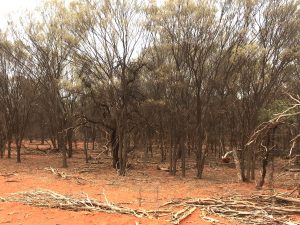Only a small proportion each year
INS infestation
In 1969 it was evaluated that 40% of the Cobar peneplain's 7.5 million hectares (3 million ha), was affected by Invasive Native Scrub. It has had 50 years to expand since then.
75km Around Cobar
At 40% infestation It is estimated there is approximately 24 million tonnes of Invasive Native Scrub in a 75 km radius around Cobar
100 years
At 250,000 tonnes/yr removal it will take 100 years to remove INS in this 75km radius, longer than the time it took for the problem to evolve in the first place.
Invasive Native Scrub
Pre white settlement the Cobar peneplain bioregion was predominantly open grassed woodland. Through pastoralists actions native woody plant species came to dominate the ecosystems. This dominance results in soil degradation, soil acidity, reduction of ecosystem diversity and agricultural productivity.
The only way to commence the restoration of grassed woodlands is to mechanically remove the scrub. Then there is the process of encouraging the grasses and herb species to grow back.

Certification
We are in the process of obtaining environmental certification for the INS removal and its resulting products. We will be implementing ISO 14000 which is the same international management certification used in Australia's forestry industry.
ISO14000 is an objective measure of environmental management and less open to local 'interpretations' of other certification schemes.
